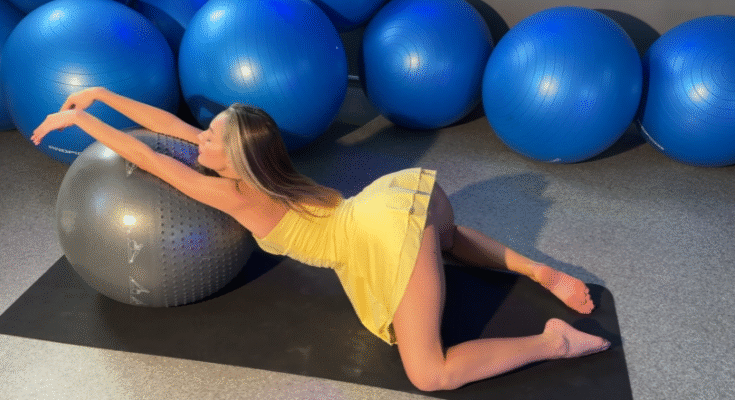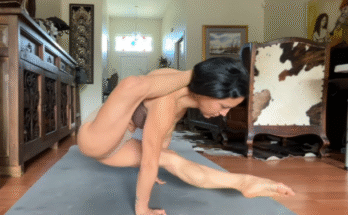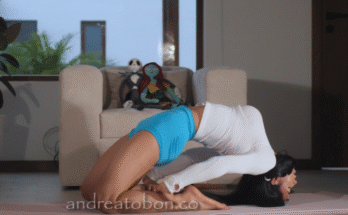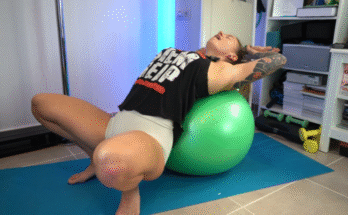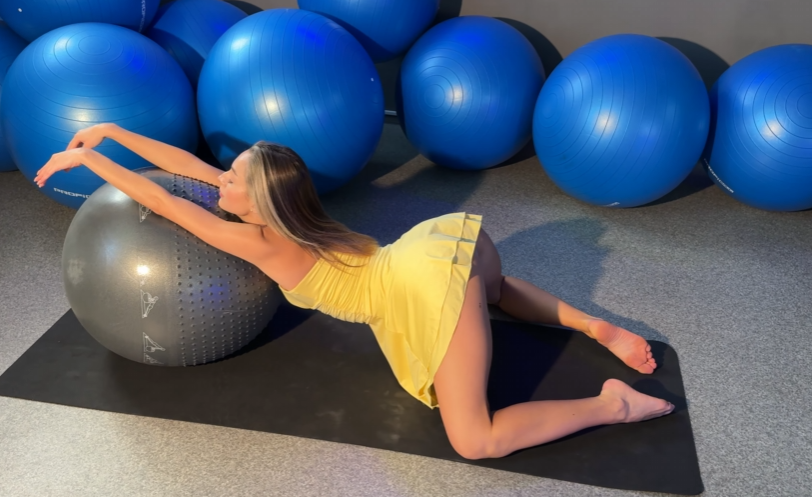
Your body is your home — and like any home, it needs care, attention, and space to breathe. Modern life makes that difficult: hours spent sitting, scrolling, typing, or commuting leave our bodies tight, our backs stiff, and our energy drained. But there’s a simple, joyful way to restore movement and balance — a full body stretch on an exercise ball.
The exercise ball, also known as a Swiss ball or stability ball, isn’t just for strength workouts or balance training. It’s an incredible tool for deep stretching, spinal decompression, and full-body relaxation. Its gentle, supportive surface helps your muscles release tension safely, while allowing your spine to move naturally.
This 1000-word guided session will take you through a slow, mindful flow — from neck to toes — to rejuvenate your entire body. Whether it’s morning, after a workout, or before bed, this routine will leave you feeling taller, looser, and more alive.
1. Settle In — Find Your Foundation (Minute 1–2)
Begin by sitting comfortably on your exercise ball. Place both feet flat on the floor, hip-width apart. Rest your hands gently on your thighs. Close your eyes and take three deep, grounding breaths — in through your nose, out through your mouth.
Feel the ball beneath you, slightly shifting as you breathe. This gentle instability wakes up your core and spinal muscles right away. Imagine your spine growing taller with every inhale, your shoulders melting down with every exhale.
Start with small hip circles — roll your pelvis slowly around the ball, first clockwise, then counterclockwise. These soft, circular movements loosen your lower back and engage your deep stabilizers. Continue for about a minute, feeling the tension melt away.
2. Upper Body Wake-Up (Minute 3–5)

Still seated, interlace your fingers and stretch your arms overhead. Inhale as you reach tall, exhale as you gently lean to the right — feeling a long stretch through your left ribs and shoulder. Return to center, inhale again, then lean to the left.
Repeat this movement a few times, flowing with your breath. The exercise ball supports your body’s micro-adjustments, allowing the stretch to travel deeper along your sides.
Next, open your arms wide into a chest opener. Reach your hands back, squeezing your shoulder blades together. Lift your chest toward the ceiling, open your heart, and breathe into your upper body.
This stretch counteracts slouching and tech-neck posture, expanding your lungs and realigning your shoulders.
Now, gently roll your shoulders forward, then backward in slow circles. Feel each movement unstick tension from your upper back.
3. Spinal Mobility (Minute 6–8)
Place your hands on your knees. As you inhale, arch your spine and lift your chin slightly — Seated Cow Pose. As you exhale, round your spine, tuck your chin — Seated Cat Pose.
Repeat this flowing motion, syncing it with your breath. The ball adds a subtle rolling motion that enhances spinal articulation and deepens your awareness of every vertebra.
After several rounds, come back to neutral. Cross your arms over your chest and gently twist your torso to the right. Keep your hips steady. Inhale through center, exhale to the left.
This rotation stretches your obliques and improves flexibility in your mid-back — a lifesaver if you sit for long hours.
4. Back Extension — Heart Opener (Minute 9–11)

Now it’s time for one of the most rewarding stretches on the ball. Carefully walk your feet forward, allowing the ball to roll under your lower back. Keep walking until your upper back and head are supported by the ball, your knees bent at 90 degrees, feet grounded.
Let your arms open wide to the sides, palms facing upward. Your chest will naturally lift, creating a deep spinal extension and heart-opening stretch.
Close your eyes and breathe deeply. Feel your ribs expanding, your spine lengthening, your front body awakening. The ball supports your natural curve, allowing gravity to gently open your chest and shoulders.
Stay here for 5–6 slow breaths. If it feels good, extend your arms overhead and interlace your fingers for an even deeper stretch.
This posture relieves tension in your chest, abdomen, and hip flexors — areas that tighten from sitting.
When you’re ready, engage your core slightly and roll yourself back up slowly to seated.
5. Hip & Hamstring Stretch (Minute 12–15)
Now kneel on the floor and place the ball in front of you. Rest your forearms on the ball and begin to roll it forward, lowering your chest toward the mat. Keep your hips above your knees and your spine long.
This position resembles Puppy Pose on the ball — an incredible stretch for your shoulders, spine, and upper back. Breathe deeply into your chest and side body.
Next, come back up and place your right leg straight on top of the ball, toes up. Flex your foot and lean forward gently from your hips — this is your hamstring stretch.
Feel the back of your thigh lengthen as you breathe into the stretch. Keep your spine long, your movements slow and intentional.
Switch sides and repeat. The ball’s support allows you to adjust easily, finding that perfect balance between comfort and challenge.
6. Core & Side Release (Minute 16–18)
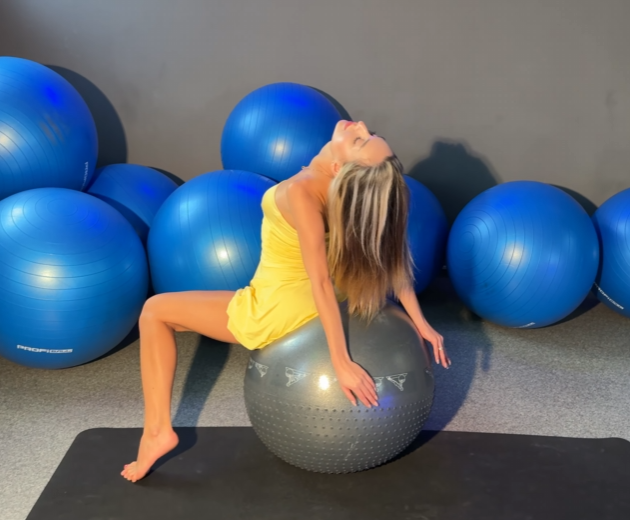
Lie sideways over the ball so that your right hip and rib cage are supported. Extend your bottom leg straight, and bend the top leg slightly in front of you for balance.
Place your right arm overhead, stretching from fingertips to toes. You’ll feel a gentle side-body stretch, perfect for releasing the obliques and intercostal muscles that tighten from daily posture habits.
If you like, extend your top arm overhead as well for a full-body reach. Hold for 3–4 breaths, then switch sides.
This stretch not only lengthens your sides but also improves spinal mobility and balance.
7. Full Back Stretch (Minute 19–21)
Sit on your knees and place your chest and arms over the ball. Let your upper body drape over it completely, resting your head and shoulders.
This Child’s Pose on the ball variation allows your spine to decompress while keeping your hips grounded. The gentle roundness of the ball supports your natural curve and relieves lower back pressure.
Breathe deeply into your lower ribs and feel your entire back expand and relax. Stay for at least a minute, letting gravity and breath do the work.
Then, walk your hands to the right to stretch your left side, then to the left to stretch your right side. Each side stretch creates space between your ribs and hips, improving flexibility.
8. Final Release & Relaxation (Minute 22–25)
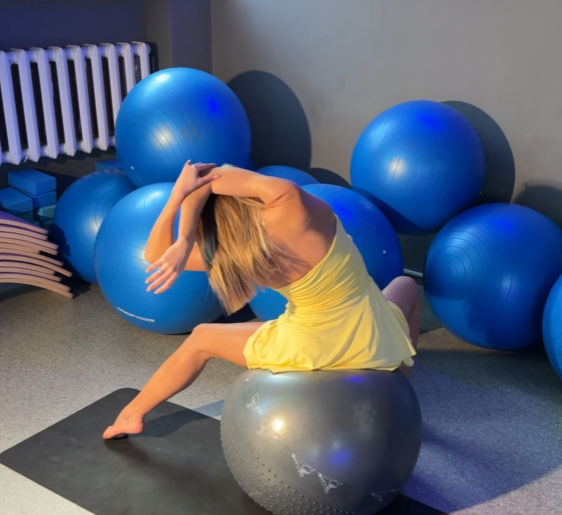
Lie down on the floor with your calves resting on the ball and your arms relaxed by your sides. Close your eyes.
This gentle supported Savasana helps relax your lower back while improving circulation.
Feel the weight of your body sink into the floor. Let your breathing slow. The ball supports you effortlessly, allowing your spine to release completely.
With each exhale, imagine tension leaving your body — from your neck, shoulders, back, hips, and legs.
Stay here for 1–2 minutes. You deserve this stillness.
When you’re ready, slowly bend your knees, roll to your side, and sit up. Bring your hands to your heart center and take one last deep, cleansing breath.
9. The Benefits of a Full Body Stretch on an Exercise Ball
- Improves posture: By supporting the natural curves of your spine, the ball helps realign your body and counteract slouching.
- Enhances flexibility: Dynamic movements allow your muscles to lengthen safely and deeply.
- Relieves back pain: The ball provides gentle traction, decompressing the spine and soothing tight muscles.
- Increases circulation: Stretching with movement promotes blood flow and muscle recovery.
- Releases emotional tension: The rolling, supportive surface encourages relaxation and mindfulness.
Final Thoughts
Your body is built to move, to bend, and to breathe freely. The exercise ball is more than just a piece of gym equipment — it’s a bridge between strength and softness, balance and release.
A full body stretch using the ball gives your spine space, your muscles freedom, and your mind peace. It’s an invitation to reconnect with yourself — not through effort, but through flow.
So the next time your body feels tight or heavy, grab your ball, take a deep breath, and let it guide you back to lightness.
Move slowly. Stretch deeply. Breathe fully.
That’s the true magic of a full body stretch on an exercise ball. 🌿🧘♀️✨
